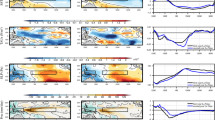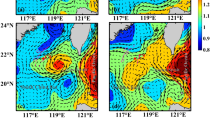Abstract
The western boundary current (WBC) in the South China Sea (SCS) flows northward in summer, closely following the Vietnam coast, and splits near 11.2° N into one eastward offshore branch named summertime eastward jet (SEJ). SEJ is significant between 110–112° E, and gradually becomes wider, shallower, weaker and warmer toward eastward until it disappears after 113.5° E. Based on the monthly mean Simple Ocean Data Assimilation (SODA) data, SEJ and its relationship with WBC on the interannual scale are studied. At the cross section 111.2° E, the current axis of SEJ (YSEJ) swings in the north–south direction with climatological value of 11.7° N and standard deviation of 0.9°, and the standard deviation of surface intensity and volume transport of SEJ (SISEJ and VTSEJ) is about 50% and 88% of the climatological value 28 cm s−1 and 4.6 Sv, respectively. In El Niño developing summers, SEJ increases its volume by 37% with 0.2° southward deviation, while in the decaying summers, SEJ decreases its volume by 43% with 0.5° northward deviation. More interestingly, SEJ has prominent correlation with the southern WBC (0.54 for VT and 0.41 for SI, > 99%), and both of them strengthen (weaken) in El Niño developing (decaying) summers. The response of SEJ and the southern WBC to El Niño can be attributed to the setting up of the anticyclonic circulation in Sverdrup balance driven by the negative wind stress curl in the southern SCS. The negative wind stress curl controls the southern WBC and further determines the transport of SEJ based on Sverdrup balance.










Similar content being viewed by others
References
Cai S, Long X, Wang S (2007) A model study of the summer Southeast Vietnam Offshore Current in the southern South China Sea. Cont Shelf Res 27(18):2357–2372. https://doi.org/10.1016/j.csr.2007.06.002
Chen C, Wang G (2014) Interannual variability of the eastward current in the western South China Sea associated with the summer Asian monsoon. J Geophys Res 119:5745–5754. https://doi.org/10.1002/2014JC010309
Chen G, Xue H (2014) Westward intensification in marginal seas. Ocean Dyn 64:337–345. https://doi.org/10.1007/s10236-014-0691-z
Chu X, Dong C, Qi Y (2017) The influence of ENSO on an oceanic eddy pair in the South China Sea. J Geophys Res Oceans 122:1643–1652. https://doi.org/10.1002/2016JC012642
Ding Y, Liu Y (2001) Onset and the evolution of the Summer Monsoon over the South China Sea during SCSMEX Field Experiment in 1998. J Meteor Soc Jpn 79:255–276. https://doi.org/10.2151/jmsj.79.255
Dippner JW, Bombar D, Loick-Wilde N, Voss M, Subramaniam A (2013) Comment on “Current separation and upwelling over the southeast shelf of Vietnam in the South China Sea” by Chen et al. J Geophys Res Oceans 118:1618–1623. https://doi.org/10.1002/jgrc.20118
Du Y, Xie S, Huang G, Hu K (2009) Role of air–sea interaction in the long persistence of El Niño-induced North Indian Ocean warming. J Clim 22:2023–2038. https://doi.org/10.1175/2008JCLI2590.1
Fang W, Guo Z, Huang Y (1997) Observational study of the circulation in the southern South China Sea. Chin Sci Bull 43(11):898–905. https://doi.org/10.1007/BF02884607
Fang G, Wang G, Fang Y, Fang W (2012) A review on the South China Sea western boundary current. Acta Oceanol Sin 31(5):1–10. https://doi.org/10.1007/s13131-012-0231-y
He Z, Zhang Y, Wang D (2013) Spring mesoscale high in the western South China Sea. Acta Oceanol Sin 32(6):1–5. https://doi.org/10.1007/s13131-013-0318-0
Hu J, Kawamura H, Hong H, Qi Y (2000) A review on the currents in the South China Sea: Seasonal circulation, South China Sea Warm Current and Kuroshio intrusion. J Oceanogr 56(6):607–624. https://doi.org/10.1023/A:1011117531252
Kuo N, Zheng Q, Ho C (2000) Satellite observation of upwelling along the western coast of the South China Sea. Remote Sens Environ 74(3):463–470. https://doi.org/10.1016/S0034-4257(00)00138-3
Li Y, Han W, Wilkin JL, Zhang WG, Arango H, Zavala-Garay J, Levin J, Castruccio FS (2014) Interannual variability of the surface summertime eastward jet in the South China Sea. J Geophys Res Oceans 119:7205–7228. https://doi.org/10.1002/2014JC010206
Liu Z, Yang H, Liu Q (2001) Regional dynamics of seasonal variability in the South China Sea. J Phys Oceanogr 31:272–284. https://doi.org/10.1175/1520-0485(2001)031<0272:RDOSVI>2.0.CO;2
Liu Q, Kaneko A, Su J (2008) Recent progress in studies of the South China Sea circulation. J Oceanogr 64(5):753–762. https://doi.org/10.1007/s10872-008-0063-8
Liu X, Wang J, Cheng X, Du Y (2012) Abnormal upwelling and chlorophyll-a concentration off South Vietnam in summer 2007. J Geophys Res 117:C07021. https://doi.org/10.1029/2012JC008052
Liu Y, Yu F, Diao X, Nan F (2014) Characteristics analysis of Vietnam offshore flow across the basin. Mar Sci 38(7):95–102 (in Chinese with English abstract)
Quan Q, Xue H, Qin H, Zeng X, Peng S (2016) Features and variability of the South China Sea western boundary current from 1992 to 2011. Ocean Dyn 66(6):795–810. https://doi.org/10.1007/s10236-016-0951-1
Su J (2004) Overview of the South China Sea circulation and its influence on the coastal physical oceanography outside the Pearl River Estuary. Cont Shelf Res 24:1745–1760. https://doi.org/10.1016/j.csr.2004.06.005
Wang B, Wu R, Fu X (2000) Pacific-East Asian teleconnection: how does ENSO affect East Asian climate? J Clim 13(9):1517–1536. https://doi.org/10.1175/1520-0442(2000)013<1517:PEATHD>2.0.CO;2
Wang C, Wang W, Wang D, Wang Q (2006a) Interannual variability of the South China Sea associated with El Niño. J Geophys Res 111:C03023. https://doi.org/10.1029/2005JC003333
Wang G, Chen D, Su J (2006b) Generation and life cycle of the dipole in the South China Sea summer circulation. J Geophys Res 111:C06002. https://doi.org/10.1029/2005JC003314
Wang G, Wang C, Huang R (2010) Interdecadal variability of the eastward current in the South China Sea associated with the summer Asian monsoon. J Clim 23:6115–6123. https://doi.org/10.1175/2010JCLI3607.1
Wang D, Liu Q, Xie Q, He Z, Zhuang W, Shu Y, Xiao X, Hong B, Wu X, Sui D (2013) Progress of regional oceanography study associated with western boundary current in the South China Sea. Chin Sci Bull 58(11):1205–1215. https://doi.org/10.1007/s11434-012-5663-4
Xiang R, Fang W, Lu Y, Huang X, Zhou S (2015) Observed three-dimensional structures of a cold eddy and an eastward jet in the western South China Sea during September 2014. J Trop Oceanogr 34(6):1–10 (in Chinese with English abstract)
Xiang R, Fang W, Zhou S (2016) The anticyclonic circulation in the southern South China Sea: observed structure, seasonal development and interannual variability. J Mar Syst 154:131–145. https://doi.org/10.1016/j.jmarsys.2015.10.004
Xie S, Xie Q, Wang D, Liu WT (2003) Summer upwelling in the South China Sea and its role in regional climate variations. J Geophys Res 108(C8):3261. https://doi.org/10.1029/2003JC001867
Xie S, Chang C, Xie Q, Wang D (2007) Intraseasonal variability in the summer South China Sea: wind jet, cold filament, and recirculations. J Geophys Res 112:C10008. https://doi.org/10.1029/2007JC004238
Xu X, Qiu Z, Chen H (1982) The general descriptions of the horizontal circulation in the South China Sea. In: Proceeding of the 1980 symposium on hydrology and meteorology of the Chinese society for oceanology and limnology. Science Press, Beijing, pp 137–145 (in Chinese with English abstract)
Zhao R, Zhu X (2016) Weakest winter South China Sea western boundary current caused by the 2015–2016 El Niño event. J Geophys Res Oceans. https://doi.org/10.1002/2016JC012252
Zu T, Wang D, Wang Q, Li M, Wei J, Geng B, He Y, Chen J (2020) A revisit of the interannual variation of the South China Sea upper layer circulation in summer: correlation between the eastward jet and northward branch. Clim Dyn 54:457–471. https://doi.org/10.1007/s00382-019-05007-5
Acknowledgements
This work was supported by National Natural Science Foundation of China (No. 41676001, 42076003) and NSFC-Shandong Joint Fund for Marine Science Research Centers (No. U1606402). The authors are thankful to the Asia-Pacific Data-Research Center at the University of Hawaii and the Climate Prediction Center of NOAA for providing the data sources. The authors also wish to acknowledge the helpful comments provided by anonymous reviewers, which significantly improve this manuscript.
Author information
Authors and Affiliations
Corresponding author
Additional information
Publisher's Note
Springer Nature remains neutral with regard to jurisdictional claims in published maps and institutional affiliations.
Rights and permissions
About this article
Cite this article
Sun, Y., Lan, J. Summertime eastward jet and its relationship with western boundary current in the South China Sea on the interannual scale. Clim Dyn 56, 935–947 (2021). https://doi.org/10.1007/s00382-020-05511-z
Received:
Accepted:
Published:
Issue Date:
DOI: https://doi.org/10.1007/s00382-020-05511-z




